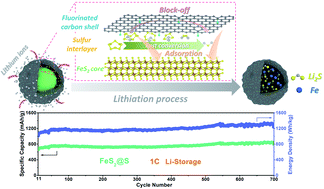Tight bonding and high-efficiency utilization of S–S moieties to enable ultra-stable and high-capacity alkali-metal conversion batteries†
Abstract
Chalcogenide cathodes with high theoretical energy densities are attracting great attention for replacing conventional intercalation cathodes in the energy storage field. However, the difficulties of spatial confinement and catalytic activation of S–S moieties retard their practical application. Herein, we propose a strategy to achieve tight bonding and high-efficiency utilization of S–S moieties by thermal sulfuration of polydopamine (PDA) coated iron difluoride. The resultant dual active-phase (FeS2@S) cathode with a fluorinated surface and cross-linked carbon network enables the preservation and rational distribution of the sulfur molecule interlayer sandwiched between the FeS2 core and in situ derived carbon shell. The in-built mixed conductive (catalytic) network in interconnected FeS2@S grains enables the achievement of ultra-stable and high-capacity (up to 1000 mA h g−1) alkali-metal conversion batteries. Superior capacity retention is achievable, e.g. 800 mA h g−1 after 700 cycles for Li-storage and 370 mA h g−1 after 1000 cycles for Na-storage even at a high rate of 1C, corresponding to cathode energy densities as high as 1200 and 480 W h kg−1, respectively. This novel cathode architecture for effective block-off of active S–S moieties provides a promising solution to sustainable conversion batteries.

- This article is part of the themed collection: Journal of Materials Chemistry A HOT Papers


 Please wait while we load your content...
Please wait while we load your content...